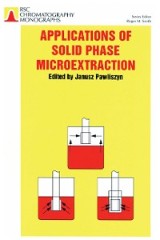Details

Applications of Solid Phase Microextraction
ISSN 1. Aufl.
|
99,99 € |
|
| Verlag: | Royal Society Of Chemistry |
| Format: | |
| Veröffentl.: | 31.10.2007 |
| ISBN/EAN: | 9781847550149 |
| Sprache: | englisch |
| Anzahl Seiten: | 674 |
DRM-geschütztes eBook, Sie benötigen z.B. Adobe Digital Editions und eine Adobe ID zum Lesen.
Beschreibungen
<p>Solid Phase Microextraction (SPME) has been introduced as a modern alternative to current sample preparation technology, and has a wide range of applications. Focusing on quantitative aspects of analysis, Applications of Solid Phase Microextraction aims to describe these applications.</p>
<p>In industry, practical uses of SPME can be found in environmental, food, pharmaceutical, clinical and forensic applications, all of which are described in this book. Important scientific applications such as reaction monitoring, characterization of coatings and distributions of analytes in natural multiphase systems are also discussed. Throughout there are descriptions of new technologies, including new coatings and interfaces for analytical instrumentation (SPME/LC and SPME/CE), automation and calibration processes.</p>
<p>Written by internationally recognised experts, edited by the scientist involved in the research since its infancy, and encompassing a wide range of applications, this book will be ideal for anyone wishing to explore the feasibility of using SPME technology.</p>
<p>In industry, practical uses of SPME can be found in environmental, food, pharmaceutical, clinical and forensic applications, all of which are described in this book. Important scientific applications such as reaction monitoring, characterization of coatings and distributions of analytes in natural multiphase systems are also discussed. Throughout there are descriptions of new technologies, including new coatings and interfaces for analytical instrumentation (SPME/LC and SPME/CE), automation and calibration processes.</p>
<p>Written by internationally recognised experts, edited by the scientist involved in the research since its infancy, and encompassing a wide range of applications, this book will be ideal for anyone wishing to explore the feasibility of using SPME technology.</p>
Foreword; Contents; Contributors; Glossary; Calibration and quantitation by SPME; Quantitative aspects of SPME; Quantitation by SPME before reaching a partition equilibrium; Coatings and interfaces; SPME coupled to capillary electrophoresis; Selectivity in SPME; Properties of commericial SPME coatings; Sol-gel technology for thermally stable coatings in SPME; Solid versusliquids coatings; Physiochemical applications; Application of SPME to study sorption phenomena on dissolved humic organic matter; The use of SPME to measure free concentrations and phospholipid/water and protein/water partition coefficients; Estimation of hydrophobicity of organic compounds; Environmental applications; Air sampling with SPME; The application of sPME in water analysis; The application of SPME to pestivide residue analysis; Inter-laboratory validation of SPME for the quantitative analysis of aqueous samples; SPME for the determination of organochlorine pestivides in natural waters; Determination of sulfur-containing compounds in wastewater; Analysis of creosote and oil in aqueous contaminations by SPME; Direct analysis of solids using sPME; Analysis of solid samples by hot water extraction -SPME; Field analysis by SPME; Organometallic speciation by combining aqueous phase derivatization with SPME-GC-FPD-MS; Metal speciation by SPME-CGC-ICPMS; The application of SPME–LC–MS to the determination of contaminants in complex environmental matrices; SPME-HPLC of environmental pollutants; Analysis of industrial pollutants in environmental samples; Food, flavour, fragrance and pheromone applications; Analysis of food and plant volatiles; Application of SPME to measure volatile metabolites produced by staphylococcus carnosus and staphylococcus xylosus; Application of SPME methods for the determination of volatile wine aroma compounds in view of the varietal characterization; Analysis of vodkas and white rums by SPMS–GC–MS; Analysis of food volatiles using SPME; Analysis of volatile contaminants in foods; Determination of pesticides in foods by automated SPMS–GC–MS; SPME in the study of chemical communication in social wasps; Pharmaceutical, clinical and forensic applications; Propyl chloroformate derivatisation and SPME–GC for screening Of amines in urine; Isolation of drugs and poisons in biological fluids by SPME; On-fiber derivatization for analysis of steroids by SPME and GC–MS; SPME–Quadrupole ion trap mass spectrometry for the determination of drugs of abuse in biological matrices; Analysis of drugs in biological fluids using SPME; SPME–Microcolumm LC: Application to toxicological drug analysis; Optimization of drug analysis by SPME; Applications of SPME for the biomonitoring of human exposure to toxic substances; Applications of SPME in criminal investigations; Reaction monitoring; SPME–GC–MS detection analysis of maillard reaction products; SPME investigation of intermediates produced during biodegradation of contaminated materials; Related techniques; Infrared spectroscopic detection for SPME; SPME in Near-IR Fiber-optic Evanescent Field Absorption Spectroscopy: A Method for Rapid, Remote In situ Monitoring of Nonpolar Organic Compounds in Water; Author Index
<br>
<br>
<br>
<br>
<br>
<br>

















